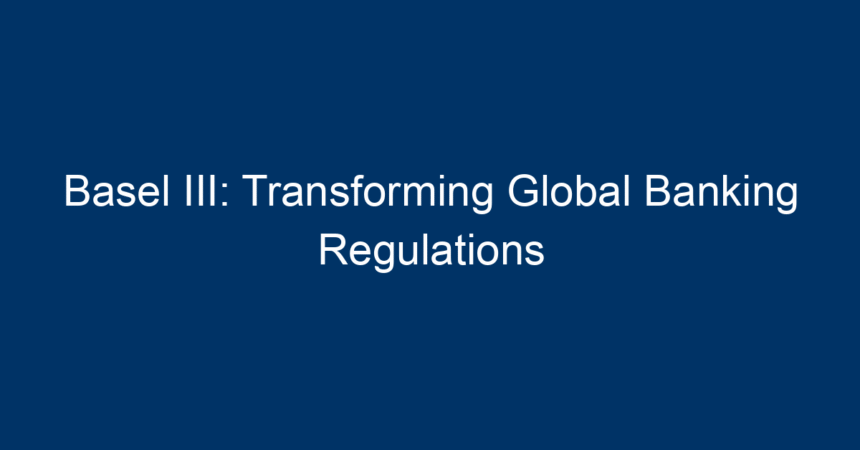Introduction
In the aftermath of the 2008 financial crisis, the world witnessed a seismic shift in banking regulations aimed at enhancing the stability and transparency of the financial system. One of the most significant reforms that emerged from this turbulence is Basel III. This comprehensive regulatory framework was devised by the Basel Committee on Banking Supervision (BCBS) to fortify the banking sector against future shocks and instill greater confidence among investors and consumers. In this article, we will delve deep into the intricacies of Basel III, exploring its core components, implementation challenges, impacts, and future outlook.
What is Basel III?
Basel III is an international regulatory framework established to strengthen the regulation, supervision, and risk management within the banking sector. It focuses primarily on improving the quality of capital banks hold, enhancing the risk coverage of the capital framework, and introducing leverage and liquidity ratios.
The Evolution from Basel I and II
To fully grasp the significance of Basel III, it’s essential to understand its predecessors—Basel I and Basel II. Introduced in 1988 and 2004 respectively, these frameworks laid the groundwork for risk management in banking. However, they were ultimately deemed inadequate in preventing systemic collapses during financial crises.
- Basel I primarily emphasized credit risk and established minimum capital requirements for banks.
- Basel II enhanced the framework by considering operational and market risks alongside credit risk, yet it still fell short during the 2008 crisis.
Basel III arose as a response to these deficiencies, introducing more stringent regulations that better reflect today’s complex financial landscape.
Key Components of Basel III
1. Capital Requirements
At the heart of Basel III are its enhanced capital requirements. The framework mandates that financial institutions maintain higher quality capital, specifically a higher ratio of common equity tier 1 (CET1) capital to risk-weighted assets (RWAs).
Common Equity Tier 1 (CET1)
Under Basel III, banks must maintain a CET1 capital ratio of at least 4.5%. This requirement ensures that banks have a substantial buffer to absorb losses during economic downturns. Additionally, the framework mandates a minimum total capital ratio of 8%.
2. Leverage Ratio
Another critical component of Basel III is the introduction of a leverage ratio. This non-risk-based measure aims to restrict the build-up of excessive leverage within the banking sector. Banks are required to maintain a leverage ratio of at least 3%, calculated as the ratio of CET1 capital to total exposure. This measure acts as a backstop to the risk-based capital ratios, ensuring that banks maintain a minimum level of capital relative to their total assets.
3. Liquidity Requirements
To address the liquidity shortfalls that became apparent during the financial crisis, Basel III introduces two key liquidity standards:
-
Liquidity Coverage Ratio (LCR): Banks must hold an adequate amount of high-quality liquid assets (HQLA) to meet their short-term obligations. Specifically, the LCR requires banks to maintain HQLA that can cover total net cash outflows over a 30-day stress scenario.
- Net Stable Funding Ratio (NSFR): This long-term liquidity measure ensures that banks maintain a stable funding profile relative to their assets and off-balance-sheet activities over a one-year horizon.
4. Countercyclical Capital Buffer
Basel III also introduces the countercyclical capital buffer, designed to increase the capital held by banks during periods of excessive credit growth. This buffer can range from 0% to 2.5% of RWAs and aims at mitigating systemic risks and amplifying credit stability throughout economic cycles.
5. Systemically Important Banks
Recognizing that some banks pose greater risks to the financial system than others, Basel III also introduces additional requirements for Global Systemically Important Banks (G-SIBs). These institutions must hold additional capital buffers to reduce the likelihood of their failure and the subsequent effects on the financial system.
Implementation Challenges
While Basel III marks a significant advancement in banking regulation, its implementation has faced multiple challenges:
1. Regulatory Divergence
Different jurisdictions have varying interpretations and implementations of Basel III standards. This divergence can complicate the global banking landscape and leads to inconsistencies in regulation.
2. Compliance Costs
The transition to Basel III necessitates substantial investment in technology, training, and risk assessment models. Many banks, particularly smaller institutions, struggle with the financial burden of compliance.
3. Impact on Lending
Higher capital requirements may lead banks to reduce lending or increase rates to maintain their capital ratios. This response could hinder economic growth, particularly in the wake of financial recovery post-crisis.
The Impact of Basel III
1. Increased Stability
One of the most significant impacts of Basel III has been the bolstering of the global banking system’s resilience. With banks holding more capital and liquid assets, they are better positioned to absorb shocks, thus enhancing overall financial stability.
2. Enhanced Risk Management
Basel III promotes more robust risk management practices, encouraging banks to adopt sophisticated risk assessment and monitoring frameworks. This shift has led to greater accountability and transparency within the banking sector.
3. Improved Investor Confidence
With stronger regulations in place, investors have more confidence in the banking system. The rigorous capital and liquidity requirements serve to reassure stakeholders about the stability and reliability of financial institutions.
Future Outlook: What Lies Ahead for Basel III?
As the global economy continues to evolve, so too must the regulatory landscape. The increasing complexity of financial markets and the emergence of new risks (such as cybersecurity threats) may necessitate further adaptations of the Basel III framework.
1. Continued Refinement
The Basel Committee is likely to refine existing guidelines and develop new regulations that reflect real-time risks. Increased collaboration among international regulators will be crucial to ensure uniformity and effectiveness.
2. Technology Integration
Advancements in technology, including AI and machine learning, will play a significant role in risk assessment and compliance practices. Banks that leverage these technologies can enhance their operational efficiency and improve adherence to regulatory standards.
Conclusion
Basel III represents a paradigm shift in global banking regulation, promoting stability, transparency, and accountability within the financial system. As the framework continues to evolve in response to changing economic conditions and emerging risks, its successful implementation will be crucial in preventing future crises.
For stakeholders in the banking sector—whether regulators, banks, or investors—understanding and adapting to these changes is vital. By embracing the principles of Basel III, the industry can foster a more stable banking environment that ultimately benefits everyone involved.
Actionable Insights
- Stay Informed: Regularly update your knowledge on Basel III regulations and their implementations.
- Embrace Technology: Invest in modern financial technologies that can streamline compliance processes and enhance risk assessments.
- Engage with Regulators: Maintain open lines of communication with regulators to better understand upcoming changes and expectations.
- Focus on Risk Management: Continuously refine risk management practices to align with Basel III requirements, ensuring that your institution is resilient against potential disruptions.
By committing to these actionable insights, stakeholders can navigate the complexities of the evolving banking landscape with confidence.




